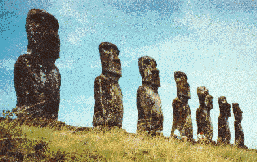

Who built these statutes and why and how did they get there?
 |
|
|
Nobody knows the answer for sure, but many are trying to find out. It has even been suggested that space aliens may have played a role regarding these giant statues. Many theories abound.
One theory suggests that Easter Island was inhabited by Polynesian seafarers, who traveled thousands of miles in their canoes, guided by the stars, the rhythms of the ocean, the color of sky and the sun, the shapes of clouds, the direction from which the swells were coming, and the presence of birds making flights out to sea seeking food. The Polynesians first arrived on the island in 400 A.D. However, the ocean currents which carried them there would not take them back. They were trapped and, having arrived there, could not leave.
It appears there may have been two classes or races of inhabitants, those with long ears and those with short ears. The long eared people were the rulers. The short eared, who came earlier, were the workers. For this reason, most of the statues have long ears.
Eventually, the short eared people revolted and killed all the long eared people.
There are 887 statutes which have been discovered on the island. However, only a few statues made it to their intended destination. The rest were abandoned along the way.
The statues appear to have been carved out of the top edge of the walls of a volcano on the island. After a statue was carved, it may have been rolled or dragged down to the base of the volcano. Then, it was stood upright and ropes were tied around it. Using a pulley system, the statue was walked to its intended destination.
The ancient grass on the island was tough and capable of being made into ropes. That grass has since almost disappeared due to sheep-herding and over-grazing. The ropes were wrapped around the statue, which was made to act as a pulley. A large group of men, perhaps 30, would pull one end of the rope, pulling one side of the statue forward. A smaller group would act as a counterweight, pulling backwards on the other end. In this way, one side of the statute could be pulled a few feet forward. Then, the process was reversed, so that the other side of the statute would come equal to the first. In this way, over a period of months, a statute could be walked for miles down to the ocean. Then, it was placed in line with other statues, all of them facing away from the sea, looking towards the center of the island.
This process was difficult. If a statue fell over in transit, as it often did, it was too heavy to be pulled upright again, so instead the islanders went back and carved another statue.
Because the making and movement of these statues required the cooperation of the entire population of the island, the people must have believed that their gods required them to build these statues.
At its peak, the population of Easter Island is believed to have reached 11,000. Finally, the resources of the island became exhausted and the people resorted to cannibalism and began eating each other. Work on the statues stopped and the statutes were knocked over. When the first Europeans finally arrived on the island, most of these people had died out.
That is just one theory, but there are other theories too. This matter has still not yet been solved. Even this theory does not address all the mysteries regarding Easter Island.
The Easter Islanders had their own system of writing, different from any other in the world. No other Pacific Islanders knew how to write. The American Indians did not know how to write either. Who taught the Easter Islanders how to write, or did they develop their own system? Remember that writing was first invented in Asia only a few thousand years BC.
The Easter Islanders lived off sweet potatoes, which they farmed. These sweet potatoes came from the Americas. How did the Easter Islanders get them? It is possible that a few Easter Islanders traveled 2300 miles to Chile, got sweet potatoes, and brought them back? This seems unlikely. Remember that the distances involved were great, further than the distance from Europe to the closest place in the Americas, which was only colonized in 1492. Could Easter Island have been colonized by people from Chile? This was the theory which formed the basis for the book and movie Kon-Tiki. Yet, DNA taken from graves dug up on Easter Island have shown that these people were Polynesians, not American Indians. The Polynesians lived on the sea and knew how to travel thousands of miles in their small canoes. They knew where they were going. The American Indians did not know how to do that. Yet, a few American Indians could have reached Easter Island, because of a storm, and brought the seeds of sweet potatoes with them. Also, the seeds could have been brought in the stomachs of birds.
As you can see, there are several theories regarding Easter Island and the statues that reside there to this very day. Many theories have even suggested the intervention of extra terrestrials from alien planets. Easter Island continues to be one of the world's greatest unexplained mysteries.
